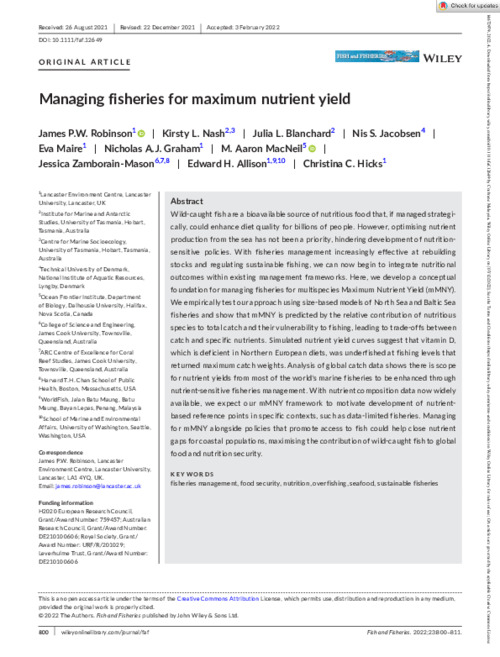Please use this identifier to cite or link to this item:
https://hdl.handle.net/20.500.12348/5353
Managing fisheries for maximum nutrient yield
| dc.creator | Robinson, J. | en_US |
| dc.creator | Nash, K. | en_US |
| dc.creator | Blanchard, J. | en_US |
| dc.creator | Maire, E. | en_US |
| dc.creator | Graham, N. | en_US |
| dc.creator | MacNeil, M.A. | en_US |
| dc.creator | Zamborain-Mason, J. | en_US |
| dc.creator | Allison, E. | en_US |
| dc.creator | Hicks, C. | en_US |
| dc.date.accessioned | 2023-01-06T09:29:17Z | |
| dc.date.available | 2023-01-06T09:29:17Z | |
| dc.date.issued | 2022 | en_US |
| dc.identifier.citation | James Robinson, Kirsty L. Nash, Julia Blanchard, Eva Maire, Nicholas A. J. Graham, M MacNeil, Jessica Zamborain-Mason, Edward (Eddie) Allison, Christina Hicks. (1/7/2022). Managing fisheries for maximum nutrient yield. Fish and Fisheries, 23 (4), pp. 800-811. | en_US |
| dc.identifier.issn | 1467-2960 | en_US |
| dc.identifier.issn | 1467-2979 | en_US |
| dc.identifier.uri | https://hdl.handle.net/20.500.12348/5353 | |
| dc.description.abstract | Wild-caught fish are a bioavailable source of nutritious food that, if managed strategically, could enhance diet quality for billions of people. However, optimising nutrient production from the sea has not been a priority, hindering development of nutrition-sensitive policies. With fisheries management increasingly effective at rebuilding stocks and regulating sustainable fishing, we can now begin to integrate nutritional outcomes within existing management frameworks. Here, we develop a conceptual foundation for managing fisheries for multispecies Maximum Nutrient Yield (mMNY). We empirically test our approach using size-based models of North Sea and Baltic Sea fisheries and show that mMNY is predicted by the relative contribution of nutritious species to total catch and their vulnerability to fishing, leading to trade-offs between catch and specific nutrients. Simulated nutrient yield curves suggest that vitamin D, which is deficient in Northern European diets, was underfished at fishing levels that returned maximum catch weights. Analysis of global catch data shows there is scope for nutrient yields from most of the world's marine fisheries to be enhanced through nutrient-sensitive fisheries management. With nutrient composition data now widely available, we expect our mMNY framework to motivate development of nutrient-based reference points in specific contexts, such as data-limited fisheries. Managing for mMNY alongside policies that promote access to fish could help close nutrient gaps for coastal populations, maximising the contribution of wild-caught fish to global food and nutrition security. | en_US |
| dc.format | en_US | |
| dc.language | en | en_US |
| dc.publisher | Wiley (12 months) | en_US |
| dc.rights | CC-BY-4.0 | en_US |
| dc.source | Fish and Fisheries;23,(2022) Pagination 800-811 | en_US |
| dc.subject | fisheries management | en_US |
| dc.subject | seafood | en_US |
| dc.title | Managing fisheries for maximum nutrient yield | en_US |
| dc.type | Journal Article | en_US |
| cg.contributor.funder | European Research Council | en_US |
| cg.subject.agrovoc | food security | en_US |
| cg.subject.agrovoc | nutrition | en_US |
| cg.subject.agrovoc | sustainable fisheries | en_US |
| cg.subject.agrovoc | overfishing | en_US |
| cg.subject.agrovoc | Fish | en_US |
| cg.contributor.affiliation | WorldFish | en_US |
| cg.contributor.affiliation | James Cook University, ARC Centre of Excellence for Coral Reef Studies | en_US |
| cg.contributor.affiliation | Lancaster University | en_US |
| cg.contributor.affiliation | James Cook University, College of Science and Engineering | en_US |
| cg.contributor.affiliation | Lancaster University, Lancaster Environment Centre | en_US |
| cg.contributor.affiliation | University of Tasmania | en_US |
| cg.contributor.affiliation | Dalhousie University | en_US |
| cg.contributor.affiliation | University of Washington, Nippon Foundation Ocean Nexus Center | en_US |
| cg.contributor.affiliation | Harvard T. H. Chan School of Public Health | en_US |
| cg.identifier.status | Open access | en_US |
| cg.identifier.ISIindexed | ISI indexed | en_US |
| cg.contribution.worldfishauthor | Allison, E. | en_US |
| cg.description.theme | Value chains and nutrition | en_US |
| dc.identifier.doi | https://dx.doi.org/10.1111/faf.12649 | en_US |
